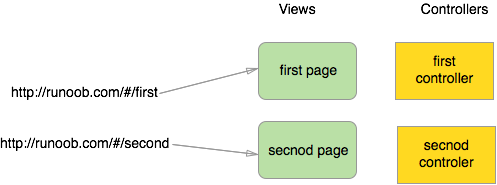AngularJS Routing
This chapter we will introduce AngularJS route.
AngularJS routed through different URL allows us to access different content.
By AngularJS can view more than a single page Web applications (single page web application, SPA).
Our URL is typically in the form ofhttp://w3big.com/first/page, but in a single-page Web applications AngularJS by # + markachieved, for example:
http://w3big.com/#/first http://w3big.com/#/second http://w3big.com/#/third
When clicking on any of the above when we have a link to the server please address are the same (http://w3big.com/). Because the content after the # sign at the end of the service request will be ignored by the browser. So we need to implement the client function of the # later in implementation. AngularJS routes to help us through a# + mark to distinguish different logical page and separate pages bound to the corresponding controller.

In the above graph, we can see that created two URL: / ShowOrders and / AddNewOrder. Each URL has a corresponding view and controller.
Next we look at a simple example:
<html>
<head>
<meta charset="utf-8">
<title>AngularJS 路由实例 - 本教程</title>
</head>
<body ng-app='routingDemoApp'>
<h2>AngularJS 路由应用</h2>
<ul>
<li><a href="#/">首页</a></li>
<li><a href="#/computers">电脑</a></li>
<li><a href="#/printers">打印机</a></li>
<li><a href="#/blabla">其他</a></li>
</ul>
<div ng-view></div>
<script src="http://apps.bdimg.com/libs/angular.js/1.4.6/angular.min.js"></script>
<script src="http://apps.bdimg.com/libs/angular-route/1.3.13/angular-route.js"></script>
<script>
angular.module('routingDemoApp',['ngRoute'])
.config(['$routeProvider', function($routeProvider){
$routeProvider
.when('/',{template:'这是首页页面'})
.when('/computers',{template:'这是电脑分类页面'})
.when('/printers',{template:'这是打印机页面'})
.otherwise({redirectTo:'/'});
}]);
</script>
</body>
</html>
Analysis examples:
1, loaded implement routing js file: angular-route.js.
2, contains ngRoute module as the main application module dependent module.
angular.module('routingDemoApp',['ngRoute'])3, using ngView instruction.
<div ng-view></div>
HTML content within the div based on route changes.
4, configure $ routeProvider, AngularJS $ routeProvider used to define routing rules.
module.config(['$routeProvider', function($routeProvider){ $routeProvider .when('/',{template:'这是首页页面'}) .when('/computers',{template:'这是电脑分类页面'}) .when('/printers',{template:'这是打印机页面'}) .otherwise({redirectTo:'/'}); }]);
config function AngularJS module is used to configure routing rules. By using configAPI, we request that $ routeProvider injected into our configuration function and use $ routeProvider.whenAPI to define our routing rules.
$ RouteProvider provide us when (path, object) & otherwise (object) function defines all routes in the order that takes two arguments:
- The first parameter is the rules of regular URL or URL.
- The second parameter is the routing configuration object.
Route Settings object
AngularJS route can be achieved through different templates.
The first argument $ routeProvider.when function is a regular rule URL or URL, the second parameter configuration of a route.Routing Configuration object syntax rules are as follows:
$routeProvider.when(url, {
template: string,
templateUrl: string,
controller: string, function 或 array,
controllerAs: string,
redirectTo: string, function,
resolve: object<key, function>
});
Parameter Description:
template:
If we only need to insert a simple HTML content in ng-view, then use this parameter:
.when('/computers',{template:'这是电脑分类页面'})templateUrl:
If we only need to insert the HTML template files in the ng-view, then use this parameter:
$routeProvider.when('/computers', { templateUrl: 'views/computers.html', });The above code will get views from the server / computers.html file content into the ng-view.
controller:
function, string or array type, controller function is executed on the current template, create a new scope.
controllerAs:
string type, specify an alias for the controller.
redirectTo:
Address redirection.
resolve:
Specifies the current controller relies on other modules.
Examples
<html>
<head>
<meta http-equiv="content-type" content="text/html; charset=UTF-8">
<script src="http://apps.bdimg.com/libs/angular.js/1.4.6/angular.min.js"></script>
<script src="http://apps.bdimg.com/libs/angular-route/1.3.13/angular-route.js"></script>
<script type="text/javascript">
angular.module('ngRouteExample', ['ngRoute'])
.controller('HomeController', function ($scope, $route) { $scope.$route = $route;})
.controller('AboutController', function ($scope, $route) { $scope.$route = $route;})
.config(function ($routeProvider) {
$routeProvider.
when('/home', {
templateUrl: 'embedded.home.html',
controller: 'HomeController'
}).
when('/about', {
templateUrl: 'embedded.about.html',
controller: 'AboutController'
}).
otherwise({
redirectTo: '/home'
});
});
</script>
</head>
<body ng-app="ngRouteExample" class="ng-scope">
<script type="text/ng-template" id="embedded.home.html">
<h1> Home </h1>
</script>
<script type="text/ng-template" id="embedded.about.html">
<h1> About </h1>
</script>
<div>
<div id="navigation">
<a href="#/home">Home</a>
<a href="#/about">About</a>
</div>
<div ng-view="">
</div>
</div>
</body>
</html>